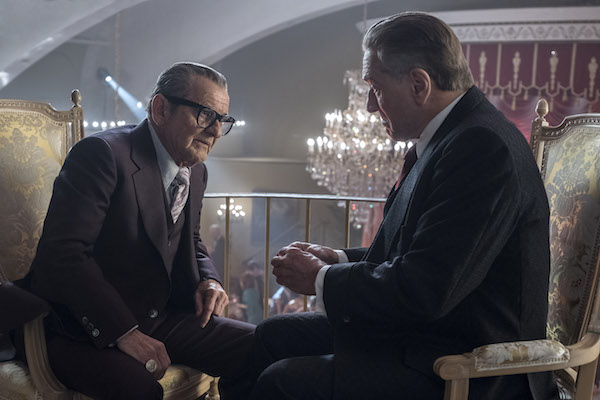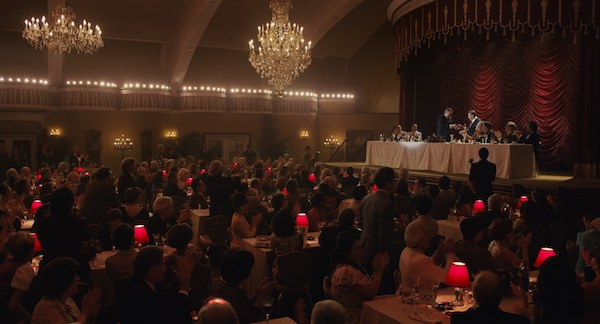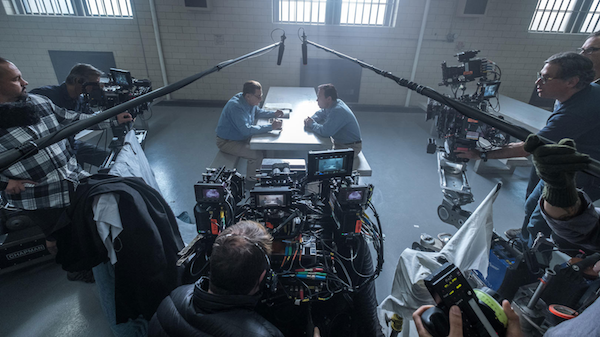
During last year’s EnergaCAMERIMAGE in Toruń, Poland, Rodrigo Prieto, ASC, AMC, attended a screening of The Irishman, participated in a post-screening question-and-answer session and press conference, then sat through a string of individual interviews — including one for Inside Hook. Some of the topics we discussed then didn’t make it into the final article, so I’m taking the opportunity to post them here.
The interview began with Mr. Prieto explaining the de-aging process used in The Irishman, then describing the special camera rig he helped devise. He talked about some of the other techniques he used in the film, notably for the car scenes, and how he duplicated the look of different film stocks over the decades during which the story takes place.
Full disclosure: I didn’t record the original interview properly and had to reconstruct it from notes. Mr. Prieto was kind enough to correct that transcript. The selections below are from his edited version.
Can you describe how you shot Frank Sheeran’s banquet? It’s on an enormous set representing the old Latin Casino, with a tremendous number of extras.
I saw that scene in the script and I realized it was going to be tough. The location was a huge space, hard to light, and then we have to drill down to these complicated emotional moments within the scene. One of my daughters happened to be watching Network, and there’s an industry dinner scene in the movie where the tables had little red lamps on them. Then for the stage there was a spotlight. I thought, this is how I’m going to do it.
Production designer Bob Shaw was skeptical, he wasn’t sure about the red lamp shades when I told him about them. He had planned to have big blue curtains up on stage and around the room. I felt the red light from the lamps would give the scene an ominous feel, while still being logical for a celebration. He ended up using gold curtains, which complemented the red lamps, and Marty liked it. So we went with that.

We needed to find private areas could have characters talk intimately, but within view of the main room, because we needed Peggy [Sheeran, played by Anna Paquin] watching them in the background. To complement the red ambient light, I put small theatrical “birdie” lamps up along the balcony rail in the perimeter of the room, they added little spots of light in the background. And then I used the spotlight to not only light the stage, but to sweep among the dancers, highlighting specific moments. For example, when Peggy’s dancing with Hoffa [Al Pacino], the light sweeps over them, and then finds Buffalino, and Tony Pro looking at Hoffa with deadly intentions.
That scene shows how critical it is to collaborate with the other department heads.
You shot a lot of The Irishman on film. Do you feel that the industry is pushing you towards using digital?
We shot all of The Silence on film, except for the candlelight scenes. I still like film, digital might be easier in low light situations, say dusk when the light is failing. But I like film, it has an organic feel to it. We can add grain to a digital image, but it’s still digital, the lines are all too straight and solid. With film, each frame changes a little bit depending on a chemical process, not an algorithm.
It seemed that about five or six years ago, it was becoming very difficult to shoot on film. Now I think it’s become a bit easier. Kodak even built a lab in New York City which we used for The Irishman.
When I was doing the color grade, I would pause over a certain shot and wonder why it felt different and I’d realize it was one that we shot on film. So even with the visual effects and the color mapping and added grain, I could still tell.
When you shoot on film you have to be more disciplined. With digital you can keep shooting forever, the director will say let’s try this or let’s try that. But when you use film, everyone on the set perks up when you roll camera. It’s a different atmosphere. I even like the feel of a film camera on the set, the hum it gives off.
Do you still operate the camera?
When it’s hand held I often do. But with digital not so much. I don’t like looking at the viewfinder screen on digital cameras because it’s not what it will look like when you’re done. So it’s better to stand back with the monitor, because that’s close to the look you will be getting. Also there I can talk to the other operators through a headset, which I wouldn’t be able to do if I am operating one of several cameras.
Do you think digital has changed the way movies are made, changed how the look of movies?
This is going to date me, but back when I started video assist was still in its early years. The image on the monitor was terrible, you would have to tell the director that the finished project would look much better. But the monitors have improved so much that now it very closely approximates what you are going to see on the screen. And the directors are back there holding these small monitors and saying to move in, they want the camera tighter, they want it closer. I think this has changed the way movies look, I think it’s made directors rely on close-ups a lot more.

Do people want to assign a visual style to you? Amores Perros has been a huge influence on cinematographers, for example.
For 8 Mile I interviewed with director Curtis Hanson four times, which I thought was weird. Finally I asked him, “Curtis is there something about me you’re not sure of?” And he said he watched the movies I shot in Mexico before Amores Perros, which were much more slick and polished, and he was worried that Amores Perros was a fluke, a one-of-a-kind thing. I told him, “Curtis, I shot it the way the story required it, it had to be gritty. For 8 Mile I will shoot it the way the material calls for.” So he did hire me. Thankfully he hadn’t seen Frida, which I shot right before 8 Mile. I really like mixing it up. Playing with different styles and genres.
What are your next projects?
I just finished The Glorias* with director Julie Taymor. And hopefully another film with Scorsese soon.
*Based on a book by Gloria Steinham, and starring Julianne Moore and Alicia Vikander, The Glorias premiered at Sundance in January.


